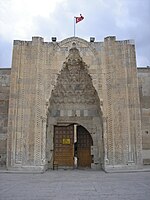Sultan Han
Sultan Han is a large and significant 13th-century Seljuk caravanserai located in the town of Sultanhanı, Aksaray Province, Turkey. It is one of the three monumental caravanserais in the neighbourhood of Aksaray and is located about 40 km (25 mi) west of Aksaray on the road to Konya.
History
This fortified structure was built in 1229 (dated by inscription), during the reign of the Seljuk sultan Kayqubad I (r. 1220-1237), along the Uzun Yolu (lit. long road) trade route leading from Konya to Aksaray and continuing into Persia. After it was partially destroyed by a fire, it was restored and extended in 1278 by the governor Seraceddin Ahmed Kerimeddin bin El Hasan during the reign of the sultan Kaykhusraw III.
Description
The caravanserai is considered one of the best examples of Seljuk architecture in Turkey. Covering an area of 4,900 square meters, it is the largest medieval caravanserai in Turkey.[1][2][3]
The khan is entered at the east, through a pishtaq, a 13-m-high gate made from marble, which projects from the front wall (itself 50 m wide). The pointed arch enclosing the gate is decorated with muqarnas corbels and a geometrically patterned plaiting. This main gate leads into a 44 x 58 m open courtyard that was used in the summer. A similarly decorated archway on the far side of the open courtyard, with a muqarnas niche, joggled voussoirs and interlocking geometric designs, leads to a covered courtyard (iwan), which was for winter use. The central aisle of the covered hall has a barrel-vaulted ceiling with transverse ribs, with a short dome-capped tower over the center of the vault. The dome has an oculus to provide air and light to the hall.
A square stone kiosk-mosque (köşk mescidi), the oldest example in Turkey, is located in the middle of the open courtyard. A construction of four carved barrel-vaulted arches supports the mosque on the second floor. The central mosque, supported by elegantly carved arches, contains a highly ornate mihrab, symbolizing spiritual guidance for visitors. (Qibla direction marker), and is lit by two windows.[4] Stables with accommodation above were located in the arcades on both sides of the inner courtyard.
Cultural and commercial significance
Sultan Han, located strategically along the Silk Road, was integral to the Seljuk Empire's efforts to bolster trade across Anatolia. These caravanserais served not only as secure stops for caravans carrying goods between Europe and Asia but also as vibrant exchange points for diverse cultural practices. Reflecting the architectural austerity typical of Seljuk design, Sultan Han’s high stone walls and elaborate main portal were designed to secure and accommodate the caravans and their cargoes. Facilities like a mescit, hamam, and refectory catered to travelers' needs, emphasizing the Seljuks' commitment to facilitating trade and cultural exchange. Funded through pious endowments, these caravanserais offered free food, fodder, and lodging, showcasing the grandeur of Seljuk hospitality and their sophisticated approach to supporting commerce and cultural interaction. Sultan Han stands out as a premier example, with its preservation contributing significantly to our understanding of the period's architectural and commercial strategies.[5]
Gallery
-
 Main entrance portal
Main entrance portal -
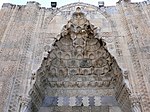 Muqarnas vaulting of the main portal
Muqarnas vaulting of the main portal -
 Decorative niche in the main portal
Decorative niche in the main portal -
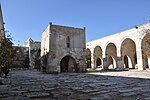 Main interior courtyard
Main interior courtyard -
 Square stone kiosk-mosque of Sultan Han
Square stone kiosk-mosque of Sultan Han -
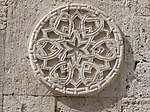 Detail of ornamental stonework on kiosk mosque
Detail of ornamental stonework on kiosk mosque -
 Interior of the mosque, including the mihrab
Interior of the mosque, including the mihrab -
 Entrance portal of the interior (winter) chambers
Entrance portal of the interior (winter) chambers -
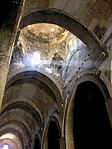 Vaults and dome in the interior (winter) chambers
Vaults and dome in the interior (winter) chambers -
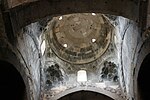 Oculus in the dome which provides air and light to the hall.
Oculus in the dome which provides air and light to the hall. -
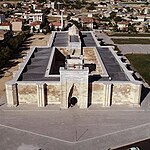 Top view of Sultanhani caravanserai aksaray
Top view of Sultanhani caravanserai aksaray
See also
- Seljuk architecture
- List of Seljuk hans and kervansarays in Turkey
References
- ^ "Sultan Han". Archnet. Retrieved 2020-07-04.
- ^ "Qantara - Sultan Han". www.qantara-med.org. Retrieved 2020-07-04.
- ^ "Sultanaksaray Han". www.turkishhan.org. Retrieved 2020-07-04.
- ^ "Sultan Han Mosque". Madain Project. Retrieved 9 April 2019.
- ^ "Seljuk Turkish Caravanserais". Turkey Travel Planner. Retrieved 2024-05-10.
Further reading
- Uluçam, Abdüsselam (2009). "SULTAN HANI". İslâm Ansiklopedisi (in Turkish). Türkiye Diyanet Vakfı. Retrieved 2024-04-28.
- Ousterhout, Robert G.; Ousterhout, Robert (2019). Eastern Medieval Architecture: The Building Traditions of Byzantium and Neighboring Lands. Oxford University Press. p. 583. ISBN 978-0-19-027273-9.
- Gierlichs, Joachim (2011). "Anatolian Seljuks; Architecture". In Hattstein, Markus; Delius, Peter (eds.). Islam: Art and Architecture. h.f.ullmann. pp. 375–376. ISBN 9783848003808.
- Ettinghausen, Richard; Grabar, Oleg; Jenkins-Madina, Marilyn (2001). Islamic Art and Architecture: 650–1250 (2nd ed.). Yale University Press. pp. 240–242. ISBN 9780300088670.
- Hillenbrand, Robert (1994). Islamic Architecture: Form, function, and meaning. New York: Columbia University Press. pp. 347–350. ISBN 9780231101332.
External links

- Sultan Han Aksaray
- v
- t
- e
- Ağzıkara Han
- Büyük Valide Han
- Büyük Yeni Han
- Caravanserai of Zor
- Hafsa Sultan Caravanserai
- Hasan Pasha Han (Diyarbakır)
- Koza Han
- Kürkçü Han
- Öküz Mehmed Pasha Caravanserai
- Öküz Mehmet Pasha Complex
- Rüstem Pasha Caravanserai (Edirne)
- Rüstem Pasha Caravanserai (Ereğli)
- Rüstem Pasha Caravanserai (Erzurum)
- Sokollu Mehmet Pasha caravanserai
- Sultan Han (Aksaray Province)
- Sultan Han (Kayseri Province)
- Suluhan

 Turkey portal
Turkey portal  Category
Category











